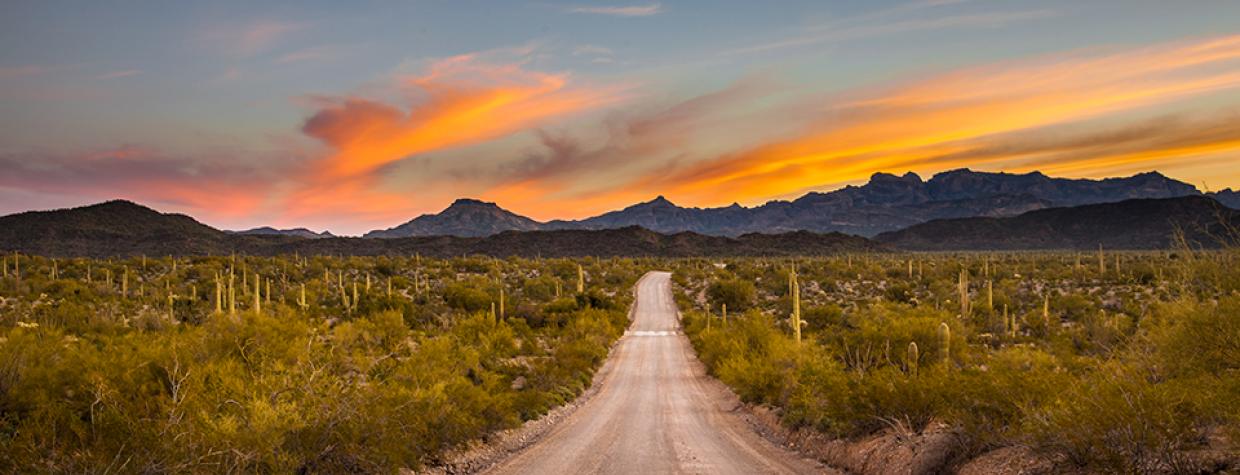You’ve probably seen organ pipe cactuses (Stenocereus thurberi) in the pages of this magazine, and with good reason: They’re among the Sonoran Desert’s most photogenic flora. But if you want to see them in person, you’ll have to head to Organ Pipe Cactus National Monument, along Arizona’s border with Mexico. It protects most of the species’ U.S. population, and Puerto Blanco Drive, a rugged 37-mile trek through the monument’s heart, offers plenty of organ pipes, along with a biodiverse oasis and panoramic desert views.
From the monument’s visitors center, off State Route 85, head northwest on Puerto Blanco Drive, which initially is a two-way road with alternating paved and gravel sections. Within a mile, you’ll get your first good look at organ pipes, but here, they’re outnumbered by saguaros and ocotillos. Be patient, because that won’t always be the case. To the north is Pinkley Peak, which you’ll pass on the left around Mile 5. This rhyolite peak, the highest point in the Puerto Blanco Mountains, is named for Frank Pinkley, a National Park Service superintendent who was key to the monument’s formation.
Next, the route becomes a one-way dirt road. It also turns much more rutted as it dips and winds through the desert landscape. You’ll want to take it slow over the ruts (there’s one at Mile 8.3 that will knock the wind out of you, or your tire, if you don’t). But in between the rough sections are relatively smooth stretches that allow you to fully enjoy the scenery.
The organ pipes take center stage around Mile 11, surrounding an appropriately cathedral-like formation on the left. Soon, you’ll be seeing dozens of them on the hillsides and near the road. These warmth-loving plants are relative newcomers to Arizona: They arrived just 3,500 years ago, as the planet thawed after the last ice age. To the northwest, the flat-topped Cipriano Hills form the backdrop for the cactuses’ silent symphony, which you can stop to enjoy at multiple picnic areas (including the now-shuttered Golden Bell Mine, at Mile 17).
At Mile 22, you’ll come to a “T” intersection. Turn left to stay on Puerto Blanco Drive, which again becomes a smooth two-way road. Huge saguaros guard the roadside as you head south 2 miles to another intersection. You’ll eventually go left, but take the half-mile side trip to Quitobaquito Springs by turning right. This isolated pond is home to three species that occur naturally nowhere else in the U.S.: the Quitobaquito spring snail, the Sonoyta mud turtle and the desert caper (also known, charmingly, as the vomitbush). It once was home to a large, frequently photographed cottonwood, but the tree was removed in 2016 to protect the dam in which it was growing. The pond, though, is still a nice place to spot wildlife or make a few photos.
From Quitobaquito, head back toward SR 85 on the southern portion of Puerto Blanco Drive, which mostly parallels the U.S.-Mexico border fence. It’s not as impressive as the northern part of the drive, but it’s also not as rugged, which means you’ll soon be back on the highway. On your way to wherever you’re headed next, think about this: Does an organ pipe cactus play only sharp notes?
Note: Mileages are approximate.
Length: 37 miles one way (from State Route 85)
Directions: From Ajo, go south on State Route 85 for 33 miles to Puerto Blanco Drive (follow signs for the Organ Pipe Cactus National Monument visitors center). Turn right onto Puerto Blanco Drive and continue 37 miles to where the road intersects SR 85 farther south.
Vehicle requirements: A high-clearance vehicle is required, but four-wheel-drive is not necessary.
Special considerations: National Park Service entrance fees apply (a vehicle pass is $25 and is good for seven days). Additionally, while the monument is safe to visit, crossings and other illegal activities do occur along the U.S.-Mexico border. Stay on maintained park roads, do not pick up hitchhikers, and report any suspicious behavior or distressed people you encounter to the monument’s staff or the Border Patrol.
Warning: Back-road travel can be hazardous, so be aware of weather and road conditions. Carry plenty of water. Don’t travel alone, and let someone know where you are going and when you plan to return.
Information: Organ Pipe Cactus National Monument, 520-387-6849 or www.nps.gov/orpi

